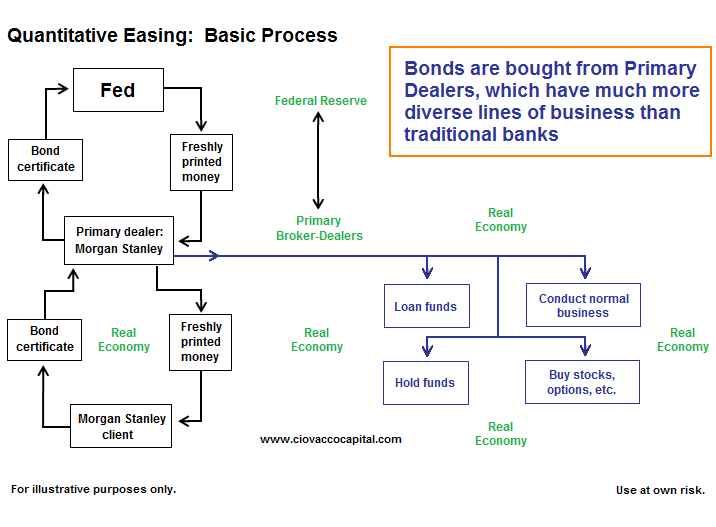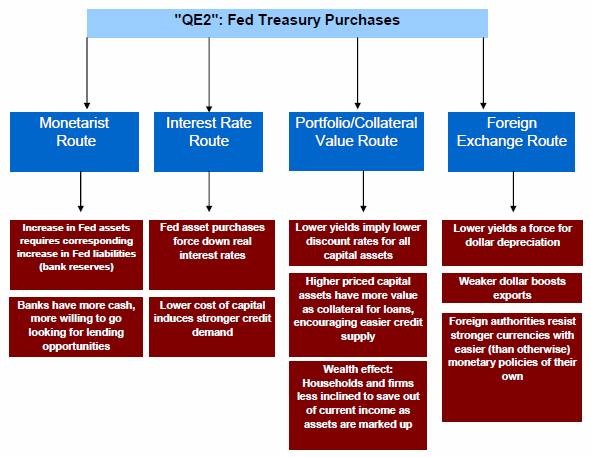Some results on Japanese quantitative easing
Post on: 16 Март, 2015 No Comment

There is a useful paper by Hiroshi Ugai, which finds mixed results, here is part of the abstract:
This paper surveys the empirical analyses that examine the effects of the Bank of Japan (BOJ)s quantitative easing policy (QEP), which was implemented for five years from March 2001 through March 2006
because of the QEP, the premiums on market funds raised by financial institutions carrying substantial non-performing loans (NPLs) shrank to the extent that they no longer reflected credit rating differentials. This observation implies that the QEP was effective in maintaining financial system stability and an accommodative monetary environment by removing financial institutions funding uncertainties, and by averting further deterioration of economic and price developments resulting from corporations uncertainty about future funding.
[yet]many of the macroeconomic analyses conclude that the QEPs effects in raising aggregate demand and prices were limited. In particular, when verified empirically taking into account the fact that the monetary policy regime changed under the zero bound constraint of interest rates, the effects from increasing the monetary base were not detected or smaller, if anything, than during periods when there was no zero bound constraint. The studies generally show that the QEP had a greater monetary easing effect than that stemming from merely lowering the uncollateralized overnight call rate to zero percent, while the effects in raising aggregate demand and prices nevertheless turned out to be limitedthe substantial decline in responsiveness to monetary easing on the part of corporations and financial institutions resulting from their deteriorated core capital due to a plunge in asset prices played a major roles.
4 comments
Bill August 28, 2010 at 8:25 am
From limited reading on this, what is interesting is that Japan did QE early, and government stimulus much later.
We did fiscal stimulus early, and will possibly be doing QE later.
Japan was criticized for doing fiscal stimulus later, rather than earlier, because doing it later was more expensive after QE had mixed results.
What is also true is that early Japanese QE was designed to promote exports to lift their economy; they did have an export lift into a growing world economy; but if the world economy is now down, it will be very difficult for the US to export its way out of this; similarly, QE was designed to alter inflationary expectations as well, causing people to purchase now, rather than wait. Changing inflationary expectations has its own problems as well.
Deflation is a threat to the debtor, while inflation is a threat to the bondholder. Short term negative real rates with QE will help the debtor and the bondholder in the short run, but negative real rates are not sustainable. Will be interesting to watch the US bond market and the TIPS market. May want to do your own personal carry trade by borrowing here and investing abroad at higher rates and waiting for the dollar to drop.
Would be interested in a comparison of QE to fiscal stimulus programs and discussion of order and mix between both policies.
William August 28, 2010 at 12:34 pm
www.princeton.edu/
ceps/workingpapers/126svensson.pdf ) writes,
This is effective only if an increase in the money supply is perceived by the private sector to be permanent. Unfortunately, there is no commitment mechanism through which a modern central bank can commit itself to a particular future money supply
And concludes,

The obvious conclusion is that the private sector does not believe that the expansion of the monetary base is permanent. The quantitative easing has not affected price-level expectations and has in this respect been a dramatic failure.
So Japans quantitative easing failed this is not really news, just look at the place now. The question is, how do you create a credible commitment mechanism? Hell, the Fed wont even commit itself explicitly to a rate of inflation. And then, how can one dismiss the potential effectiveness of QE based on a severely crippled implementation?
Yancey Ward August 28, 2010 at 4:23 pm
Maybe Japan is a best case scenario.
Bill August 28, 2010 at 9:16 pm
I have a question concerning the difference between the dollar and the yen as it relates to their uses as reserve currencies.
The experience with QE with the yen and the dollar might be different insofar as the dollar is a reserve currency, and the yen is less of one.
Would QE of a reserve currency have a different effect than QE of a non-reserve currency on total world outputin other words, does reserve currency status have a different dynamic for QE with respect to the total world economy quite apart from its effect on the US market?
Comments on this entry are closed.














